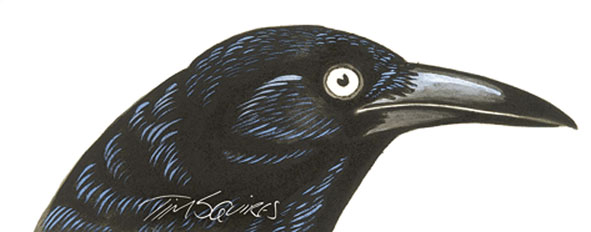 LIFE isn’t all fun and games for the gangs of ravens we seen going around town in huge flocks during the winter months.
LIFE isn’t all fun and games for the gangs of ravens we seen going around town in huge flocks during the winter months.
The ravens are mainly juveniles flexing their muscles, and wings, for a winter and spring of mayhem before attempting to find mates and settle down to family life.
This aspect of raven behaviour has been described by scientists as a sort of mobile discotheque – with groups of young males fighting for dominance and females trying to find mates. The latest research, however, puts it in the context of the Big Brother reality show in which communal life is shown to have its stresses and strains.
My mail is full of raven antics at this time of the year but the research carried out in Poland suggests it is a winter of discontent for the young crows. And just like humans, or more appropriately human teenagers, the life of a young raven finding his or her way in life can be full of angst and pain.
The study of the European ravens has found that birds living in juvenile gangs are more stressed than those in adult pairs. Scientists analysing droppings found higher levels of stress hormones among birds living in “teenage” groups.
Our forest ravens (Corvus tasmanicus) are of a different species to the European ravens studied, of course, but members of the raven grouping within the crow family show remarkably similar behaviour, including roaming in flocks before pairing and mating, and settling down with one partner.
The study didn’t mention anything about vandalism and hooning but reading a report of it I surmised that ravens in Europe get up to all the same sort of tricks as those in Hobart.
My favourite raven stories include one about a group of birds dropping stones through the windows of a city-centre hotel atrium (possibly because the ravens thought the stones were mussels and they were trying to break them open, as gulls do on the beach). As for flying hoons, a reader once phoned to report that ravens were flying at break-neck speed through the canopy of a eucalypt in her garden, just swerving at the last moment to avoid colliding with the tree’s trunk.
The study by Dr Nuria Selva and her team in Poland’s Bialowieza Forest was more concerned with comparing the life, and health, of juvenile ravens with those of adult ones who had formed pairs. The findings, published in the journal Biology Letters, contradict theories that living in territorial pairs is more energetically demanding than co-operative group life.
Researchers now suggest that stress could be a driving factor in ravens’ maturation from groups to pairs and the pressures of gang life could drive young ravens to set up home in a more stable adult relationship.
Young birds live together in social groups and co-operatively share food. Adult birds, meanwhile, form pairs, often for life, and aggressively defend their breeding territory.
Scientists had set out to investigate how stressful these different social systems were.
“In the case of ravens, it is clear that food finding and sharing is easier when a group of 30 ravens is searching for a carcass, than when only two ravens do it,” Dr Selva said “But our study shows that life in groups is not so heavenly as traditionally thought.”
Previous theories have identified the benefits of group living because young ravens do not have to defend territory or forage alone. The new study’s analysis of raven droppings on the forest floor told a different story. The juvenile gangs’ droppings contained much higher levels of the stress hormone corticosterone than the adult pairs’.
The new evidence suggests it may be more energetically demanding to live in groups than to maintain a territory. Competition for dominance could cause the increased stress.
Dr Selva also says stress could be a significant factor in ravens’ maturation.
“We think that having high stress levels can be an important reason to leave the group,” she said. “Somehow, we feel it has many similarities with human life – stressful life in teenage gangs versus a more peaceful live in a pair.”